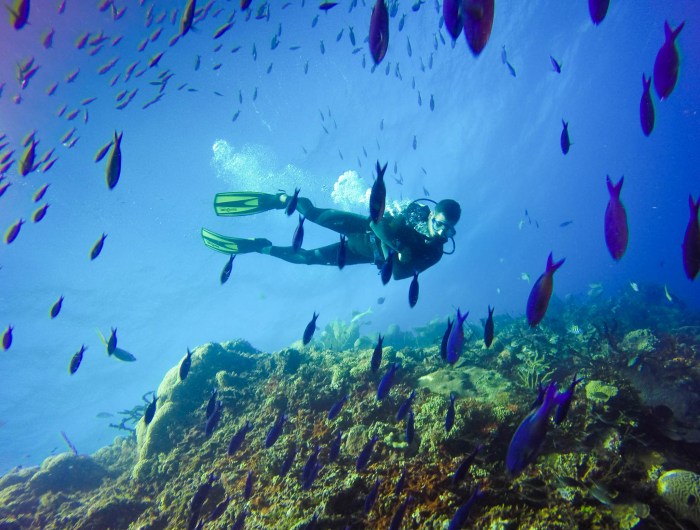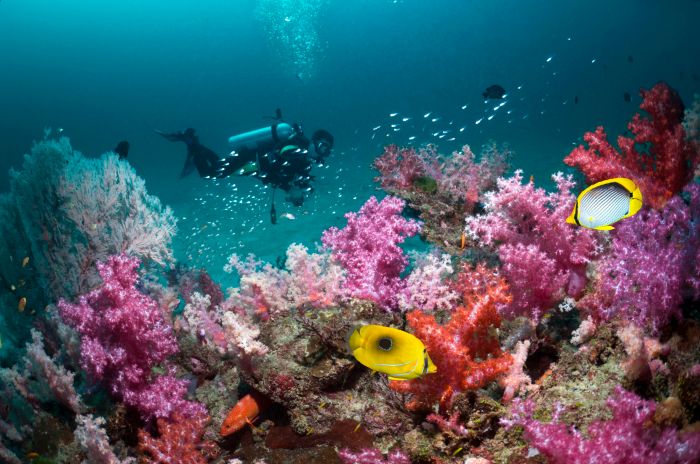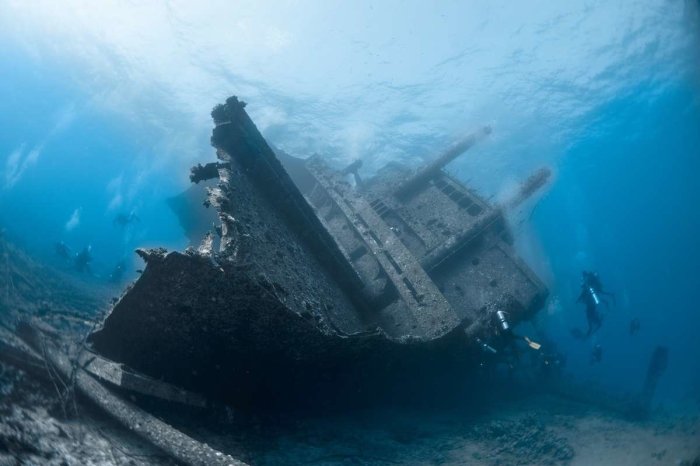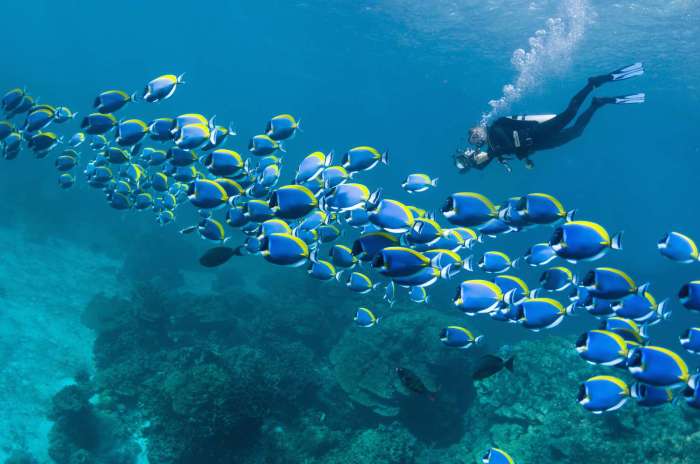Scuba diving locations offer an unparalleled opportunity to explore the hidden depths of our planet’s oceans. From vibrant coral reefs teeming with life to mysterious underwater caves and shipwrecks, the underwater world holds countless wonders waiting to be discovered.
In this comprehensive guide, we’ll delve into the most captivating scuba diving destinations around the globe, showcasing their unique marine ecosystems, ideal diving conditions, and unforgettable experiences that await beneath the waves.
Scuba Diving Destinations

Scuba diving offers a unique opportunity to explore the underwater world and encounter a vast array of marine life. From vibrant coral reefs to sunken shipwrecks, there are countless destinations around the globe that cater to divers of all levels.
The best time to visit a particular scuba diving destination depends on the location and the type of diving experience you are seeking. Some destinations, such as the Caribbean, offer year-round diving, while others, such as the Maldives, have specific seasons that are better for diving.
The best scuba diving locations offer a breathtaking underwater experience, showcasing vibrant coral reefs, diverse marine life, and underwater caves. Whether you’re a seasoned diver or a beginner, you can find the perfect destination for your adventure at scuba diving locations.
From the crystal-clear waters of the Caribbean to the pristine dive sites of the Pacific, there’s a scuba diving location waiting to captivate your senses and create memories that will last a lifetime.
Great Barrier Reef, Australia
The Great Barrier Reef is one of the most popular scuba diving destinations in the world. It is home to a vast array of marine life, including over 1,500 species of fish, 400 species of coral, and 4,000 species of mollusks.
The best time to visit the Great Barrier Reef is during the winter months (May to October), when the water is clearer and the visibility is better.
Maldives
The Maldives is a group of islands in the Indian Ocean that is known for its crystal-clear waters and white-sand beaches. The Maldives is home to a wide variety of marine life, including manta rays, whale sharks, and sea turtles.
The best time to visit the Maldives is during the dry season (November to April), when the weather is calm and the visibility is good.
For the most thrilling underwater experiences, scuba diving enthusiasts seek out captivating locations worldwide. Whether exploring the vibrant coral reefs of the Caribbean or encountering majestic marine life in the Pacific, there’s a dive site to suit every adventurer. And if you’re looking for travel inspiration beyond the depths, dive into Hello world! , a captivating blog that transports you to awe-inspiring destinations, enriching your understanding of our planet’s diverse cultures and natural wonders.
As you surface from the underwater realm, let Hello world! guide you to new horizons, expanding your knowledge and appreciation for the world’s beauty.
Galapagos Islands, Ecuador
The Galapagos Islands are a group of islands in the Pacific Ocean that are known for their unique wildlife. The Galapagos Islands are home to a variety of marine life, including sea lions, penguins, and marine iguanas.
The best time to visit the Galapagos Islands is during the dry season (May to November), when the weather is calm and the visibility is good.
Cozumel, Mexico
Cozumel is an island in the Caribbean Sea that is known for its pristine coral reefs. Cozumel is home to a variety of marine life, including stingrays, sea turtles, and dolphins.
The best time to visit Cozumel is during the dry season (November to May), when the weather is calm and the visibility is good.
Scuba diving offers a fascinating opportunity to explore the underwater world and witness its hidden wonders. Whether you’re an experienced diver or a novice, there are numerous scuba diving locations worldwide that cater to all levels of expertise. From vibrant coral reefs teeming with marine life to enigmatic wrecks that tell tales of maritime history, the underwater realm holds a wealth of experiences waiting to be discovered.
Raja Ampat, Indonesia
Raja Ampat is a group of islands in the Indonesian archipelago that is known for its stunning coral reefs. Raja Ampat is home to a variety of marine life, including sharks, rays, and sea turtles.
The best time to visit Raja Ampat is during the dry season (May to October), when the weather is calm and the visibility is good.
Scuba Diving Safety

Scuba diving is an exciting and rewarding activity, but it’s important to remember that it can also be dangerous. By following proper safety procedures and taking the necessary precautions, you can help to minimize the risks and enjoy a safe and enjoyable dive.
One of the most important aspects of scuba diving safety is proper equipment use. Make sure that your equipment is in good working order and that you know how to use it properly. This includes your mask, fins, snorkel, and buoyancy compensator device (BCD).
Dive Planning
Before you go diving, it’s important to plan your dive carefully. This includes choosing a dive site that is appropriate for your skill level and experience, and checking the weather forecast to make sure that conditions will be safe.
- Check the weather forecast before you go diving.
- Choose a dive site that is appropriate for your skill level and experience.
- Make sure that your equipment is in good working order.
- Plan your dive carefully and stick to your plan.
Emergency Procedures
In the event of an emergency, it’s important to know what to do. This includes knowing how to perform basic first aid, how to use your emergency equipment, and how to contact emergency services.
- Know how to perform basic first aid.
- Know how to use your emergency equipment.
- Know how to contact emergency services.
By following these safety tips, you can help to minimize the risks associated with scuba diving and enjoy a safe and enjoyable dive.
Scuba Diving Equipment

Scuba diving equipment is essential for exploring the underwater world safely and comfortably. The basic equipment includes a mask, snorkel, fins, buoyancy compensator device (BCD), scuba tank, regulator, and weight belt.
Mask
A scuba mask allows you to see clearly underwater. It should fit snugly around your face to create a watertight seal and provide a wide field of vision.
Snorkel
A snorkel is a tube that allows you to breathe while floating on the surface of the water. It is attached to the mask and provides an air passage when you raise your head above the water.
Fins
Fins are worn on your feet to propel yourself through the water. They increase your speed and efficiency while swimming.
Buoyancy Compensator Device (BCD)
A BCD is a vest-like device that helps you control your buoyancy underwater. It has an inflatable bladder that you can fill with air to become more buoyant or release air to become less buoyant.
Scuba Tank
A scuba tank is a metal cylinder that holds compressed air for breathing underwater. It is attached to the BCD and provides a constant supply of air through the regulator.
Regulator
A regulator is a device that reduces the high pressure of air in the scuba tank to a breathable level. It delivers air to your mouth through a mouthpiece.
Weight Belt
A weight belt is used to add weight to your body to help you sink underwater. The amount of weight you need depends on your body composition and the weight of your equipment.
Scuba Diving Training: Scuba Diving Locations
Scuba diving training is essential for anyone who wants to explore the underwater world safely and confidently. There are different levels of scuba diving certification available, each with its own requirements and skills that are taught.
Beginner Level
The beginner level certification, often referred to as Open Water Diver, is the starting point for most scuba divers. This certification typically involves classroom instruction, pool sessions, and open water dives. During the training, students learn the basics of scuba diving, including how to use scuba gear, dive safely, and manage emergencies.
Advanced Level
After completing the beginner level certification, divers can progress to the advanced level. This certification typically involves more advanced skills, such as deep diving, navigation, and night diving. Advanced divers are also trained to handle more challenging underwater environments and emergencies.
Rescue Level
The rescue level certification is designed for divers who want to be able to assist other divers in distress. This certification typically involves training in rescue techniques, such as how to perform underwater rescues, administer first aid, and manage dive emergencies.
Master Level
The master level certification is the highest level of scuba diving certification. This certification typically involves advanced training in a variety of diving disciplines, such as technical diving, cave diving, and ice diving. Master divers are highly experienced and skilled divers who are able to handle the most challenging underwater environments and emergencies.
Benefits of Scuba Diving Training
There are many benefits to obtaining scuba diving training. These benefits include:
- Safety: Scuba diving training teaches divers how to dive safely and confidently, reducing the risk of accidents and injuries.
- Skills: Scuba diving training provides divers with the skills they need to explore the underwater world safely and enjoyably.
- Knowledge: Scuba diving training teaches divers about the underwater environment and how to protect it.
- Fun: Scuba diving is a fun and rewarding activity that can be enjoyed by people of all ages and abilities.
Finding a Reputable Training Agency
When choosing a scuba diving training agency, it is important to consider the following factors:
- Reputation: Choose a training agency with a good reputation for providing high-quality training.
- Experience: Choose a training agency with experienced instructors who have a proven track record of success.
- Curriculum: Choose a training agency with a comprehensive curriculum that covers all of the essential scuba diving skills.
- Location: Choose a training agency that is conveniently located and offers flexible training schedules.
By following these tips, you can find a reputable scuba diving training agency that can help you achieve your diving goals safely and confidently.
Scuba Diving Environment

Divers encounter a wide range of underwater environments, each with its own unique challenges and hazards. Understanding these environments and the associated risks is crucial for safe and enjoyable diving experiences.
The type of underwater environment divers may encounter can vary greatly, from shallow coral reefs to deep ocean trenches. Each environment presents its own set of challenges and hazards, such as strong currents, limited visibility, and marine life.
Shallow Water Diving, Scuba diving locations
Shallow water diving, typically conducted in depths of less than 30 meters, offers relatively mild conditions. However, divers must still be aware of potential hazards such as coral reefs, which can cause cuts and abrasions, and strong currents, which can carry divers away from their intended path.
Deep Water Diving
Deep water diving, conducted in depths exceeding 30 meters, presents more significant challenges. Divers must contend with increased pressure, which can lead to decompression sickness if not managed properly. Additionally, deep water diving requires specialized equipment and training to ensure safety.
Cave Diving
Cave diving involves exploring underwater caves and caverns. This type of diving requires specialized skills and equipment, as divers must navigate through tight spaces and manage potential hazards such as silt, limited visibility, and disorientation.
Wreck Diving
Wreck diving involves exploring sunken ships and other underwater structures. While this can be a fascinating experience, divers must be aware of potential hazards such as sharp edges, entanglement risks, and the presence of marine life.
Tips for Diving Safely in Different Underwater Environments
- Research the specific environment you plan to dive in, including its potential hazards and challenges.
- Receive proper training and certification for the type of diving you intend to do.
- Use appropriate equipment and gear for the environment you are diving in.
- Be aware of your surroundings and monitor your depth and time underwater.
li>Dive with a buddy and stay within your limits.
Scuba Diving Experiences

Scuba diving is an activity that can provide an array of thrilling and unforgettable experiences. The allure of the underwater world and the thrill of exploring it up close make scuba diving an attractive adventure for many.
Underwater, divers encounter a mesmerizing realm of vibrant coral reefs, playful marine creatures, and fascinating underwater landscapes. Each dive offers a unique and awe-inspiring adventure, as divers witness the beauty and diversity of the marine ecosystem.
The Thrill and Excitement of Exploring the Underwater World
Scuba diving provides an unparalleled opportunity to explore the underwater world and encounter its wonders firsthand. Divers can witness the grace of sea turtles, the playful antics of dolphins, and the mesmerizing colors of coral reefs.
The thrill of discovering hidden underwater caves, navigating through narrow passages, and encountering marine life up close creates a sense of exhilaration and awe. The underwater world offers a realm of endless exploration, where each dive holds the potential for new discoveries and unforgettable experiences.
Benefits of Scuba Diving for Personal Growth and Well-being
Beyond the thrill and excitement, scuba diving also offers numerous benefits for personal growth and well-being.
- Stress Relief: The calming effects of being underwater, surrounded by the tranquility of the marine environment, can help reduce stress and promote relaxation.
- Confidence Building: Overcoming the challenges of scuba diving, such as learning to control buoyancy and navigating underwater, can boost self-confidence and a sense of accomplishment.
- Improved Physical Fitness: Scuba diving requires physical exertion, including swimming and carrying equipment, which can contribute to improved cardiovascular health and overall fitness.
- Environmental Awareness: Scuba diving provides a firsthand perspective on the beauty and fragility of the marine ecosystem, fostering a greater appreciation for environmental conservation.
Epilogue

Whether you’re a seasoned diver or a curious novice, embarking on a scuba diving adventure promises an unforgettable journey of discovery, wonder, and personal growth. As you immerse yourself in the underwater realm, you’ll witness the extraordinary beauty and fragility of our oceans, inspiring a deep appreciation for the natural world.
General Inquiries
What are the most popular scuba diving destinations?
Some of the most popular scuba diving destinations include the Great Barrier Reef, Maldives, Galapagos Islands, Raja Ampat, and the Red Sea.
What is the best time of year to go scuba diving?
The best time of year to go scuba diving varies depending on the destination. However, in general, the best time to dive is during the dry season or when the water is warmest.
What are the different types of scuba diving experiences available?
There are many different types of scuba diving experiences available, including wreck diving, cave diving, night diving, and drift diving.